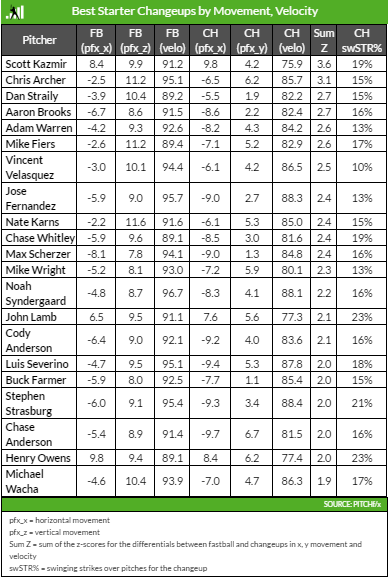Luis Severino, a Changeup, and a Little Bit of Luck
Luis Severino had a great 2015 in his two-month debut, and was supposed to take a big step forward in 2016. Luis Severino took a big step backward in 2016. He was sent back to Triple-A in May, and when he came back late in the season, he was almost exclusively used as a reliever (albeit with incredible results). The reason for his struggles is pretty clear, even on the back of his baseball card – a 1.39 HR/9 rate. So clearly, the homer problem is what we’ll be looking into today, but what if I showed you this?

*as SP
You’ll see that I only used his numbers as a starting pitcher; they would be skewed in his favor if I included his dominant innings as a reliever. Even so, the number of fly balls were extremely low, he wasn’t being hit very hard…in fact, he was generating a lot of infield pop-ups and a lot of soft contact in general. This is the opposite of what one would expect from a pitcher with a homer problem. It gets even weirder.

His issue in 2016 was homers, but in the roughly one-third of his innings as a starter in the first time against an opposing batting order, he beat the league average and his own 2015 mark, which had actually been below league average. And for good measure, in the other roughly one-third of his innings that he was a relief pitcher, he gave up zero home runs. That’s befuddling. But there is a silver lining to this; we now know where the problem is. Clearly, Severino’s problems lie in the second and third time through the opposing order. We can finally find the glaring problems there.

Severino’s problems can be summed up in this table. While his groundball rate was still healthy and even above league average, there was still a significant decrease from the 51.9% mark he posted in 2015 in the same circumstances. When his groundball rate dropped, his line-drive rate rose to the point that would tie Mike Fiers for the league lead (and that isn’t a good thing). So the increased line drives were part of the problem, and as the saying goes, increased line-drive rate equals higher BABIP. In Severino’s case, “higher” means .394, which is, by the nature of the statistic, absolutely unsustainable. Additionally, the 3.0 HR/9 is extremely ugly (as expected, since this is where we deduced the homer problem to be), and yet the HR/FB rate can expect positive regression as well.
Now, before we pin all of Severino’s troubles on luck, let’s remember that he is responsible for turning those ground balls he was getting in 2015 into line drives. Severino went from throwing his changeup 12.8% of the time in 2015 to only 8.9% in 2016, essentially becoming a fastball/slider only pitcher. Without an offspeed pitch or even a third offering of any sort, Severino naturally became rather predictable as the game went on. I am not sure exactly why Severino scrapped his changeup, and this Eno Sarris chart you’re about to see will only puzzle us further.

The entire article deserves a full read for context, but by Sarris’ metric, Luis Severino had the 16th-best changeup among starters in 2015. Maybe there are some imperfections with PITCHf/x, maybe the sample size was too small, but batters only hit .222/.323/.259 against it, so the results back up the metric. That kind of effectiveness would have gone a long way for Severino in 2016. To the Yankees’ credit, the only instructions they gave Severino when he was sent back to the minors were to work on his changeup. Later in the season, after the Yankees called him back up to New York, Severino was deployed as a relief pitcher, allowing him to continue his two-pitch ways.
Clearly, there are two factors we were able to pin down that derailed Luis Severino. Some of the problem for him was terrible luck, as the .394 BABIP and 31.0% HR/FB are likely to come back down to earth. Some of the problem was self-inflicted, like the abandoning of his changeup, which at 57.9% in 2015 was a groundball machine, leading to more line drives in 2016. The recipe for success is there for Severino, both in his right arm and in the wishes of the Yankee management. Take spring-training stories for what you feel they are worth, but it sounds like Severino is working on reincorporating that 2015 changeup back into his repertoire. If it is indeed back, beginning with his first start scheduled for April 7, expect Severino to take the step forward in 2017 that he was supposed to take in 2016.
All stats via FanGraphs
Matt is an undergrad at the UConn School of Business. He knows that Daniel Norris has a 0.92 ERA in the first inning going back to 2016, and that Brandon Nimmo has a 148 wRC+ against RHP in his career. Follow him on twitter @matthewmocarsky!